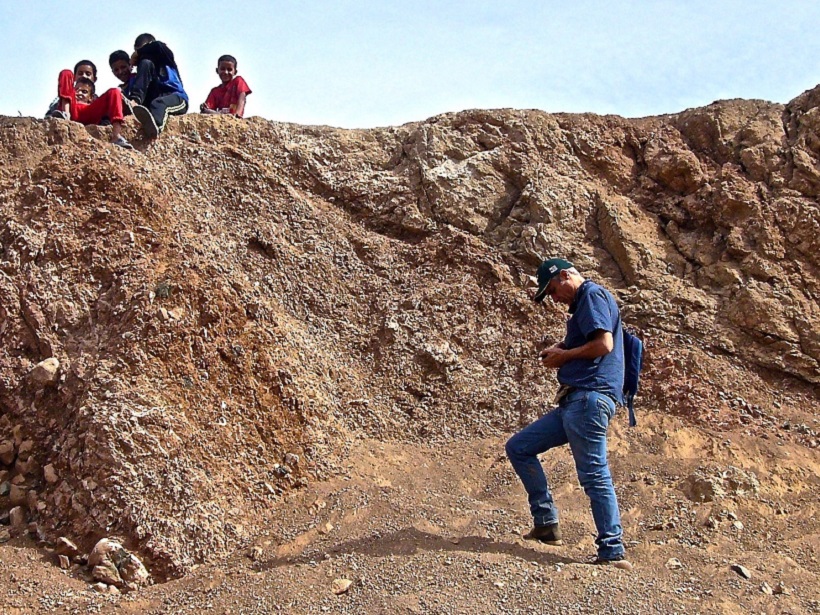We are delighted to announce that Claudio Faccenna will be the next Editor in Chief of Geochemistry, Geophysics, Geosystems (or G-Cubed). He will officially start on 1 January 2018 but has already begun the transition process. We asked him some questions about his own research interests and his vision for the journal.
What is the focus of your research?
My interests lie in understanding the surface geological expressions of mantle dynamics. While the solid earth community is generally divided between mantle and surface/lithosphere dynamics, I always try to bring my geological expertise within a mantle dynamic perspective. As with many of us, I can hardly resist the enchanting charm of mountain belts so one of the things that I focus on is orogenic processes in terms of mantle dynamics. Mountain belts result from the complex feedbacks between surface processes, crustal deformation and mantle dynamics. Their interaction and feedback may reveal unexpected links between climate, tectonics and mantle convection. Field studies have always represented for me an infinite source of inspiration and ideas that I test using geodynamic models. I have been involved in studies along the Tethyan belt from the Mediterranean to the Middle East and the Himalaya, the Andes and the Transantarctic Mountains.
What does it mean to you to serve as Editor in Chief of Geochemistry, Geophysics, Geosystems?
After a long period spent on the editorial board of the AGU journal Tectonics, moving to G-Cubed represents a new challenge and a fantastic opportunity. G-Cubed is an important journal for the Earth science community as it publishes papers covering a wide range of disciplines. I think this broad scope is fundamental for our community as it provides inspiration for an interdisciplinary approach to investigate coupling and feedbacks between the different processes of the Earth system. I have always promoted this approach as it is profoundly rooted in my cultural background. Working for G-Cubed represents an opportunity for me to further help our community explore this interdisciplinary path.
What is your vision for the journal over the coming years?
Thanks to the work done by the outgoing Editor in Chief, Thorsten Becker, and the Editorial team, G-Cubed has grown in terms of recognition in the Earth science community as a leading journal. My main goal is to keep along this course, attracting cutting-edge, cross-disciplinary papers, exploring emerging fields, and promoting interdisciplinary studies. A journal such as G-Cubed has the potential to foster a new approach for exploring the Earth system and this may have direct impact on a range of disciplines.
Likewise, it has the potential to spread excellent science worldwide, and to encourage a new generation of Earth scientists, especially in underrepresented countries, towards this new interdisciplinary approach. It is my opinion that new ventures and collaborations with underrepresented countries represent a fundamental step forward for our scientific community. They require an extra-effort from all of us but I feel motivated in that direction.
What new research directions in Earth sciences would like to see in the journal?
G-Cubed should give attention to grand challenges and emerging or hot topics, encouraging our community into unexplored fields between disciplines. We already launched a number of “themes” and we should continue further along this path, proposing cross-disciplinary topics at the frontiers of research. For example, feedback and coupling between climate, mantle dynamics and tectonics; volcanism, climate and evolution of life; bridging time-scales between long-term and short-term processes; and integrated planetary sciences are all interesting areas of interdisciplinary fields of research. The electronic format of the journal is particularly adapted to these new challenges and I hope it can be further developed for these new emerging requirements.
—Claudio Faccenna, Dipartimento Scienze, Università Roma TRE, Italy; email: [email protected]
Citation:
Faccenna, C. (2017), Introducing the new editor in chief for G-Cubed, Eos, 98, https://doi.org/10.1029/2018EO086969. Published on 30 November 2017.
Text © 2017. The authors. CC BY-NC-ND 3.0
Except where otherwise noted, images are subject to copyright. Any reuse without express permission from the copyright owner is prohibited.

